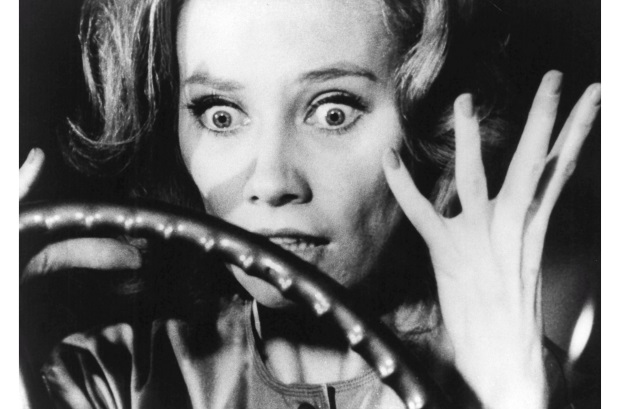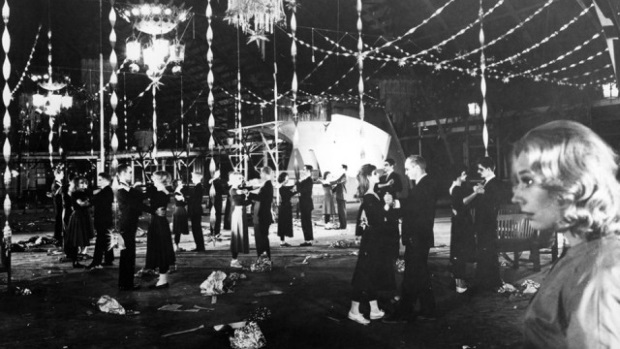Carnival Of Souls: The Strange Story Behind the Greatest Horror Movie You’ve Never Seen
Dancing Mormon ghosts, dodgy distributors and a barely-there budget couldn't stop Herk Harvey from crafting a creepy modern classic
This article comes from Den of Geek UK.
“Anybody that produces a film runs into problems when they come to distribution,” said director Herk Harvey told Timothy De Paepe in 1983, somewhat understating the reality of the trials he endured while making his 1962 directorial debut, Carnival Of Souls. Not just distribution, but budget, filming permissions and location difficulties all contributed to his film’s unconventional birth. Perhaps the strangest thing about it, though, is that despite a legendarily problematic production, Harvey succeeded in crafting a horror film with such enduring and haunting power, it inspired the likes of George A. Romero, David Lynch, and M. Night Shyamalan, and continues to earn new fans today.
It all began in 1961. While driving back from Los Angeles to his home in Lawrence, Kansas, Harvey glimpsed a shadowy ruin on the outskirts of Salt Lake City. Pulling over to explore, he discovered the Saltair Pavilion, an abandoned ballroom that had a bewitching air of faded grandeur. At the time a payroll director at Centron – which produced educational and industrial films – Harvey was looking to break into features, and the pavilion struck a spark of creativity in his mind. “The whole place looked sort of weird,” he said. “I just catalogued it away.”
When he got home, Harvey called up his friend and fellow Centron worker John Clifford, and asked if he’d write a feature based around the pavilion. “The last scene, I told him, had to be a whole bunch of ghouls dancing in that ballroom,” remembered Harvey to the LA Times in 1990 (via Offscreen view for UK readers). “The rest was up to him.”
Completing the script in just three weeks, Clifford dreamt up the story of church organist Mary Henry (Candace Hilligoss), who survives a car accident after a drag race gone wrong. But as she attempts to get on with her life and takes a job in another town, she can’t shake a feeling of wrongness after the crash – a feeling that manifests in the form of a white-faced figure who follows her wherever she goes. But who is ‘the Man’, and what does he want?

Assembling a crew of just five – himself, cinematographer Maurice Prather, editor Dan Palmquist, assistant director Reza Badiyi, and production manager Larry Sneegas, all of them his buddies at Centron – Harvey managed to generate a budget of $33,000 after approaching local Kansas businessmen, who invested in packs of the production’s stock. And he found his lead in the form of up-and-coming actress Candace Hilligoss, who turned down a role in Psychomania (1963) to star in Carnival Of Souls. “I was paid $2,000 for doing the film,” she later recalled. “It seemed like a fortune.”
Meanwhile, Harvey himself would play ‘the Man’, masterminding the character’s look by using white greasepaint on his face and wet salt in his hair for a crusty long-dead appearance. “That was part ego and more economics,” he explained of playing the role. “Mostly economics. When you’ve only got $17,000 cash, you get thrifty.”
Thriftiness was the name of the game as Harvey found cunning ways not only to save money but also film on location. On Sept.18, 1961, the first shooting day, he descended on the Kaw Bridge in Eudora, Kansas for the film’s drag race. Having promised he would cover the damages for the scene, which involved the car crashing through the side of the bridge, Harvey ended up footing a damages bill of just $17. He also paid $25 to a stranger to drive his van through an alley after a fleeing Hilligoss, and another $25 to a department store clerk who let them shoot a scene in a dressing room.

Finally, on Oct. 1, 1962, Harvey and his crew arrived at the derelict Saltair Pavilion, where they proceeded to create the sequence that Harvey had first imagined for the film. Renting the ruins from the Salt Lake City Chamber of Commerce for just $50 – and tracking down the pavilion’s original technician to turn on the ballroom lights – he staged the film’s ghostly dance scene with the help of students from the Mormon School of Modern Dance.
Wrapping filming was only the beginning of the story, though. Harvey signed a seven-year rights agreement with LA distributor Herts-Lion, but Herts-Lion promptly assembled a bizarre and misleading ad campaign, asked Harvey to add in nude scenes (he refused), and oversaw nine minutes of cuts so that Carnival Of Souls could show as a drive-in double feature with The Devil’s Messenger. “I took off to do a series of seven industrial films in South America,” Harvey said. When he got back, he asked Herts-Lion to send him his royalties, and they mailed him a check. “It bounced,” he said. “I knew we were in trouble.”
In 1964, Herts-Lion shut its doors, but not before it inadvertently set the wheels in motion that helped Carnival Of Souls become a belated underground hit. The film’s broadcast rights were pimped out to 187 TV stations across America, and duly Carnival Of Souls ran and re-ran in late-night slots for the better part of a decade.
Slowly, its atmospheric, eerie and beautifully shot story earned a cult status among horror fans, who noted its arthouse inspirations (Ingmar Bergman, Jean Cocteau), and the film became the inspiration for the likes of Night Of The Living Dead, David Lynch’s pasty-faced ‘Mystery Man’ in Lost Highway, The Sixth Sense, and even Insidious.
Happily, Harvey lived long enough to see his film enjoy success as a theatrical re-release in 1990 (he passed away from pancreatic cancer six years later). Carnival Of Souls remains his sole directing credit, which is a tragedy in itself, but his film has survived thanks to his considerable artistry, deft handling of understated horror, and an ethereal lead performance from Hilligoss. “Death keeps calling her back,” Harvey said of his film’s protagonist, and the same certainly applies to his film, which continues to lure in viewers old and new.